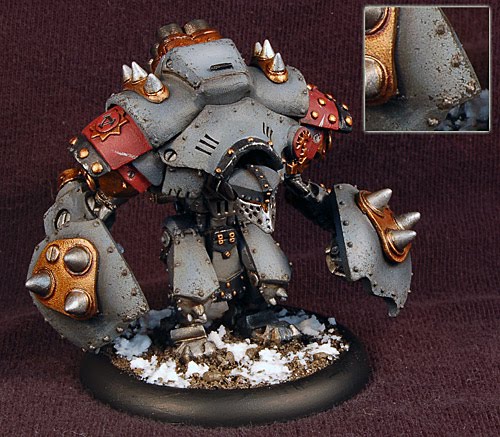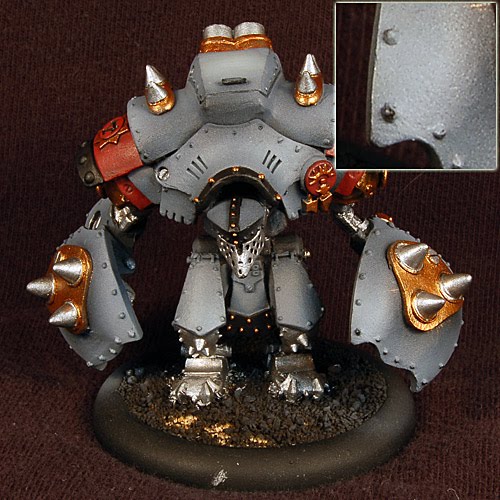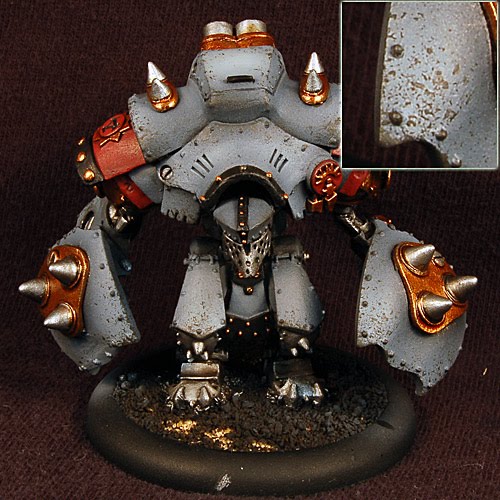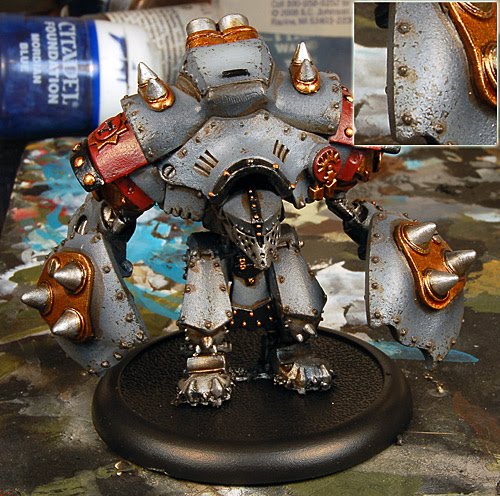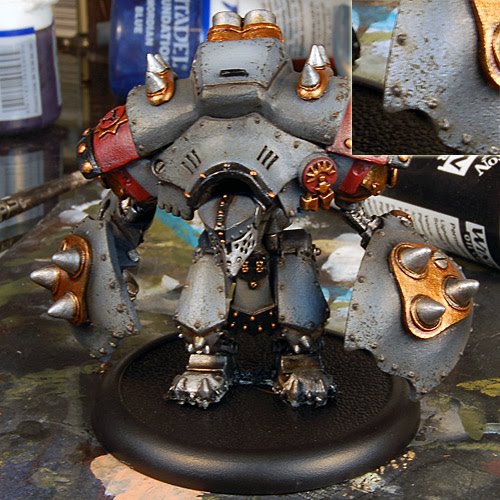Hobby: Weathering 101

Hey Guys, Col_Festus here to give you the low down on a cool technique to weather your models! You’ll want to see this one.
So with the release of MKII and my new obsession with Warmachine I knew I wanted to paint my Warjacks with a realistic feel to them. To achieve this I applied my modified approach to weathering that can be found in Forgeworld’s Masterclass book. This is an advanced technique that requires numerous tools and the use of oil paints, it is not for the novice. You will require the following:
- Oil paints of choice (W&N Lamp Black and Burnt Umber)
- W&N Sansordor
- Heat Gun
- Pledge: Future Floor Wax
- Matte Varnish
- Sponge (from blister packs)
- Airbrush
Ok so let’s get into it!
Step one
Paint your model as per normal. Here I didn’t apply any washes or shading as I wanted to add it later with my oil paints in the weathering process to achieve a natural look. The only shading this model has is the natural shading I was able to achieve with my airbrush. Here I based all the gray areas with Vallejo Model Air U.S. Grey and then did a spotted base of U.S. Light Gray. All the red areas were a simple brush application of Citadel’s Mechrite Red. All the metal areas were based with Chainmail, or Dwarven Bronze (a few layers of Dwarven Bronze will be required).
Step 2
Now it was time to add paint chipping to the basecoat, and depth to the metals. A piece of foam from blister packs was used to apply the chipping. It was dipped in Charadon Granite and wiped almost clean. It was then dabbed on the hard edges of the model as well as areas that would receive wear and tear. The metals received washes to help make them look more realistic. The bronze received a wash of Pledge Future Floor Wax (Klear for our readers over the pond) and GW’s Brown Ink in about a 1:1 mix ratio. The silver got a simple wash of Babdab Black from GW’s wash line. Once everything was dry I loaded up my airbrush with Pledge: Future Floor Wax (PFFW) and gave the model 2 heavy coats. Not only does this provide great protection to the foundation layers but it will serve as a smooth surface to help “tease” our oil paints around on to create a natural weathering look.
Step 3
Now for the weathering! The process it a two step process. The first is laying down the coloring you want, followed by “teasing” it into the surrounding surface to achieve a natural weathered look. I used oil paints to do this. I simply took a glob of W&N Burnt Umber on my brush and put it on my painting pallet. I then thinned it by adding a few drops of W&N Sansodor. The result was a liquid with similar consistency of GW’s washes. I then proceeded to use this the same way I would a wash. I let it flow around rivets, into crevices and any other area I thought dirt would accumulate. Once everything was in place I used a heat gun on LOW to dry the paints. It took about 5 minutes of heat gun work to get everything dry.
***WARNING*** the gun gets EXTREMELY hot and if you keep the gun in the same area for too long it WILL melt your model. I can vouch for this as you will see in the next picture. The poor Kodiak’s original base was melted right to my pallet and had to be swapped out.
The model should now look something like this:
Step 4
As you can see the wash is dry and its nice and bold. It’s now time for the “teasing”. To do this you simply take a clean brush and dip it in your Sansodor. Clean off almost all of the liquid on the brush as if you were going to use a dry brushing technique. Once dry simply swirl the brush around the puddles of dry wash and they will begin to disperse. Stop when you achieve the desired look. You can also pull and push the wash any which way. I found the oil paints to be pretty easy to work with. If you mess up you can simply take a Q-tip with Sansodor on it and clear the area off. Once your happy with the effects simply seal it on by applying a coat of PFFW. Once that is dry repeat the whole process using W&N Lamp Black instead of Burnt Umber. This is what we have after all of the oil techniques are complete.
Step 5
The final step is to touch up any areas that need it. Once that’s complete I took Chainmail and went around hard edges dabbing at the model. This represents areas of extreme weathering and wear that have taken the paint down to the metal. Once everything was dry I gave the entire model 2 coats of Vallejo’s Matte Varnish. I then took a brush and applied PFFW to any metal areas to help bring them back to life. The finished result looks like this!
~So there you have it guys! This is the technique I’ve used on all my jacks to great effect. This simple technique can also be used to weather tanks and infantry. The process remains the same with any model you use. I’ve found that oil paints can give you some very impressive shading and is very easy to correct if you make mistakes. You can see more of the technique put to use over at my blog First Rank, Second Rank! As always if you have any questions pertaining to this technique or painting in general feel free to email me at [email protected]!

